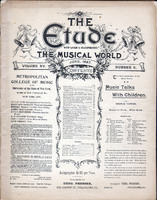Speaking of choir matters, Dudley Buck says, in the Sunday School Times, that: “1. The choir is supposed to sing with spirit and precision, not accommodating itself to the dragging tendency of the congregation. This is the purpose for which the choir is supposed to have been organized. A congregation accustomed to listen to such rendering would soon lose much of its inherent sluggishness, and, by natural or unconscious imitation, acquire the habit and style desired. Meantime the choir must have within itself the firmness of rhythm wished for, in order to affect the congregation. So the choir has its separate rehearsal with the organ, and we will suppose its membership to be extremely amateurish, both as regards voices and general lack in scientific ability. Suppose, further, that the music to be studied is new to the performers. It will soon be noticed (1) that the organ helps where it should not help; (2) that it conceals that which it should not conceal; and (3) that it does not aid in overcoming the rhythmic lassitude which the average chorus choir assumed is certain to bring with it. With the presupposed rehearsal conditions, the organ tone (even if softly played) envelops the voices, unduly sustaining them where self-reliance should be the rule, and casting a sort of veil over all sorts of minor musical iniquities on the part of individuals, which, in the aggregate, amount to much. After all, in this connection, the old-fashioned New England choirs of fifty to seventy-five years ago had a true artistic basis with their ‘pitch- pipes’ and tuning-forks. They had to find the desired accent and rhythm within themselves. This meant independence of accompaniment. Nor was their problem a simpler one than that of to-day. Many of their old tunes are much more intricate than the present tunes. However, we are happily rid of the majority of them. We have no quarrel with the ‘survival of the fittest.’ One fact remains: frequent occasional singing without accompaniment is excellent rehearsal practice for any choir. The organ does not assist this training. It helps too much, and may easily lead to general dependence.
“2. The organ so employed in rehearsal conceals faults from both organist and director (these two offices should be united in one person wherever possible). When the choir rehearses with the organ in a church otherwise empty, there is not infrequently a carrying out and carrying over of the tone into the body of the edifice, rendering it very difficult, not to say impossible, for the conductor to judge what the voices are really doing. The singers themselves feel this to a great extent, if the music is unfamiliar. The choir will usually hear itself better when a congregation is present. Meantime, seated near the organ, the tone of which itself ‘carries over’ the heads of the singers, both choir and conductor are at a manifest disadvantage in respect to the very purpose for which they are assembled.
“3. The lack of rhythmic impetus is even more felt under the above conditions than with a full church, especially while the learning process is going on.
“It is the conviction of the writer that nearly all choir rehearsals should be held with piano, only resorting to the organ after correctness has been secured—not only as to mere notes, but also as to style and expression.
“The advantages of the piano rehearsal, held in a smaller room than the church proper, are not far to seek. The choir can be grouped around the instrument. Its tones give the pitch, and start the choir with the most definite rhythm. On the other hand, when the full chorus commences, the evanescent quality of the piano is practically absorbed and covered for the time being, but its rhythm can be felt. Thus the individual singer is thrown largely upon his or her own resources, and the conductor can far more readily discover and correct errors of which he might be oblivious were the organ the accompanying instrument. Best of all, a crisp and marked accentuation can be continuously given by the piano, which thus tends directly to overcome the lagging and dragging referred to. Rehearsed in this manner, voices soon acquire the habit of promptitude and exactness in rhythm. This they will carry with them subsequently to the organ, and further impart to a congregation. Then comes the joint effect as it should be. In this way, that which was spoken of as lacking in the organ is overcome, and the desired result obtained. If the choir but sing independently, ‘lustily, and with a good courage,’ any organist worthy of the name can support and enhance the effect.
“In conclusion, and to put it as concisely as possible, I regard the organ plus an effective chorus choir as one joint instrument—in detail doubtless complex, but serving united in the one result, ‘ad major em gloriam Dei!’”



